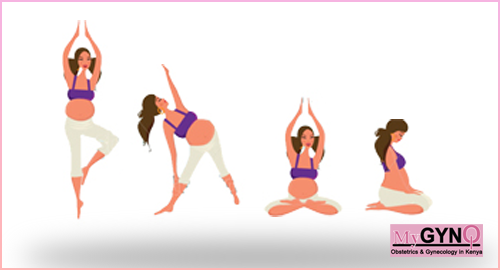- Clinic:
- 0733 945 717
- 0739 434 212

Where the best of women’s healthcare is found
May 10, 2023
Medical consent is an inalienable right
May 15, 2023Exercise in pregnancy

In this day and age of physical fitness, many women retain a strong desire to continue exercises during pregnancy.However, many harbor questions about the safety of physical fitness in pregnancy. Most physical exercises are safe, and in fact are beneficial in many respects. The activities chosen should be ones where body balance is well maintained, not too strenuous, and should not confer potential direct trauma to the developing foetus
Scientific studies show that adverse pregnancy outcomes are not increased by physical exercises.
There are many musculoskeletal changes in pregnancy that must be taken into account while choosing physical activity types. The joints become more lax, and the range of mobility may be increased.
Thus caution should be exercised with contact and weight bearing sports which are best supervised by a health professional. Pelvic support belts may be worn to provide extra support.
Precautions include maintaining hydration, avoiding hot and humid gyms, ingesting adequate calories and limiting continuous sessions to about 45 minutes. While taking a breather, pregnant women should avoid lying on their backs as this compromises blood circulation and may lower blood pressure.
Aerobics and strength conditioning exercises as part of pregnancy healthy lifestyles are completely safe. The aim should be to maintain good fitness without trying to reach peak performance or competitive training.
Walking, jogging and cycling are all safe as well, taking care to maintain body balance to avoid falls. Many pregnant women enjoy swimming, which is safe in comfortable pool temperatures. Scuba diving should however be avoided as there is risk of decompression and gas embolism.
Maternal benefits of keeping fit in pregnancy are both physical and psychological. Expectant and fit mothers experience less fatigue, less difficulties with sleeping; and less stress, anxiety and depression. Their psychological health is better, and they seem to experience shorter and less complicated labors. The fetus benefits as well, with better tolerance of the process of labor.
Keeping physically fit should continue even after delivery. Physical exercises can be resumed immediately following an uncomplicated delivery. Pelvic floor exercises are especially important in aiding the pelvic muscles to regain their pre-pregnancy strength. This reduces problems with urinary, and in some cases fecal incontinence. Confidence with resumption of sexual activity is also boosted by a feeling of good pelvic muscular function. It is worth noting that physical exercises do not interfere with milk production, both in terms of quality and quantity.
Some co-existent medical conditions in pregnancy however require that physical exercises be directly supervised by a health professional. Such conditions include heart and lung disease, bleeding in pregnancy, premature labor or pregnancies where fetal growth is sub-optimal.
Physical exercises should be immediately terminated should there be chest pain, excessive shortness of breath, bleeding or other potentially serious problems. In such situations, medical help must be summoned immediately.
Take a fertility test today
